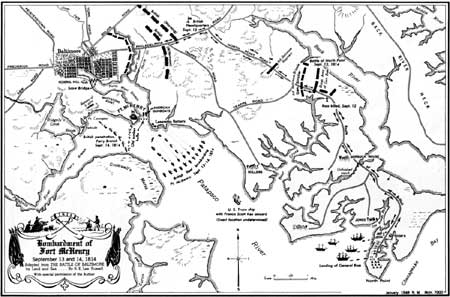|
FORT McHENRY National Monument and Historic Shrine |
 |

Early print of the bombardment of Fort McHenry.
Courtesy Maryland Historical Society.
The Bombardment of Fort McHenry
To render effective assistance to Brooke's army, it was necessary for Cochrane to reduce Fort McHenry, which barred the entrance to Baltimore harbor. At dawn on September 13, 16 warships, including five bomb ships and one sloop equipped with rocket launchers, dropped anchor about 2 miles below the fort and commenced an intensive bombardment. The Americans responded with a brisk fire, but, much to their disappointment, their shot and shell fell short. The superior range of the 13-inch sea mortars on the bomb ships, reported Maj. George Armistead, commander of Fort McHenry, exposed the garrison to a constant and tremendous shower of shells." In the early afternoon, a bomb landed on the southwest bastion of the fort, dismounting a gun and inflicting casualties on the crew. During the excitement, three bomb ships approached the fort but were quickly driven off by the Americans.
In its description of the action on the 13th, Niles' Weekly Register wrote that "Four and five bombs were frequently in the air at a time, and, making a double explosion, with the noise of the foolish rockets and the firings of the fort, . . . created a horrible clatter." Armistead's report of the action on this day omits any mention of rockets, thus making it difficult to discuss the role played by the rocket ship, H. M. S. Erebus.
The critical period of the attack developed shortly after midnight when a picked British force under Captain Napier penetrated the branch of the river to the right (west) of the fort. Their mission, Armistead believed, was to storm the fort. Before they could land, however, they were detected and subjected to a withering fire from the guns of Fort McHenry and the two smaller works, Forts Babcock and Covington. The British fought back strongly with cannon and rockets. In the inky darkness, the Americans trained their weapons by the muzzle blasts of the enemy guns and the blaze of their rockets. Gradually, American fire power prevailed, and Napier was compelled to retire to the warships, safely anchored beyond the range of even the 42-pound cannon of the fort.
The British repulse impelled Admiral Cochrane to suspend the attack. A messenger was dispatched to Colonel Brooke to inform him of the admiral's decision and to advise him to move his troops back to the transports. Brooke, confronted with the perplexing problem of attacking a city defended by powerful entrenchments and manned by troops superior in numbers to the English, hastily accepted Cochrane's advice.
After a final bombardment, which lasted until 7 o'clock on the morning of the 14th, the fleet got under way and moved down river. Thus the fort, by denying the British access to the North West Branch, had frustrated the British strategy for the capture of Baltimore. The failure to take Baltimore also strengthened the position of the American peace negotiators at Ghent.
Armistead estimated that the British had hurled between 1,500 and 1,800 shells at the fort, of which number about 400 landed within the defense works. Two of the buildings were severely damaged, the others received slight injury. The casualty list was amazingly small. Of the 1,000 defenders, only 4 were killed and 24 injured. The appearance of the fort after the attack is picturesquely described in an entry of the Orderly Book of the Lebanon Blues which mentions that:
The captain was at Fort McHenry and reports it is all cut up Round about it—he brought A piece of the bumb shell with him—he further says that there is some so large that they weigh 200 lbs.
Measures were immediately undertaken to repair and strengthen the fort. The Committee of Vigilance and Safety was asked to furnish heavy timbers to build a covered way and brick to strengthen the magazines and erect bombproofs. It was also asked to repair those gun carriages which had failed to withstand the shock of recoil. Above all, Armistead stressed the need for 13-inch mortars and appropriate shells.

Map of the bombardment of Fort McHenry.
(click on image for an enlargement in a new window)

|
|
Last Modified: Mon, Dec 2 2002 10:00:00 am PDT |


